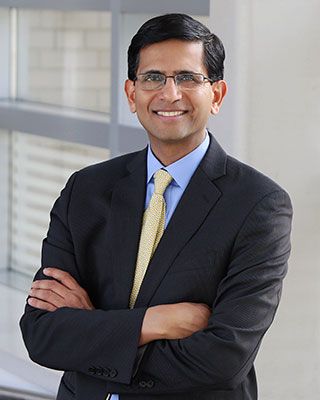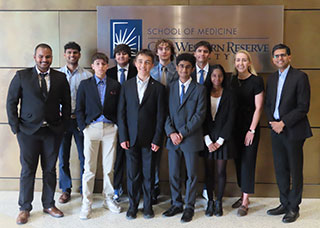December 17, 2024
On a typical day, Sanjay Rajagopalan, M.D., balances clinical responsibilities as a cardiologist; administrative duties as a leader of a division and an institute; and his NIEHS-funded research at University Hospitals, Case Western University, in Cleveland, Ohio.

“It's the mission of the NIEHS to highlight the role of the environment in health. That's a personal mission for me, too,” said Sanjay Rajagopalan, M.D. (Photo courtesy of Rajagopalan)
Rajagopalan’s ultimate goal is to find ways to prevent the health problems stemming from environmental pollution, a large contributor to death and mortality worldwide.
Rajagopalan studies how exposure to environmental factors such as air pollution — particulate matter smaller than 2.5 microns, called PM2.5 — contributes to cardiometabolic disorders, such as insulin resistance, hypertension, cardiovascular disease, obesity, and type 2 diabetes.
In 2021, he won a prestigious NIEHS RIVER Award to support exploration into how PM2.5 exposure can lead to cardiometabolic disorders by disrupting circadian rhythms — 24-hour cycles that regulate sleep and wakefulness, hormonal activities, body temperature, and metabolism. Short for Revolutionizing Innovative, Visionary Environmental Health Research, the RIVER program provides researchers with flexibility and sustained support to pursue new research questions.
“I truly enjoy ‘bench to bedside and back to bench’ approaches,” said Rajagopalan, who is also chief of cardiovascular medicine and chief academic and scientific officer at the Harrington Heart & Vascular Institute of Case Western’s University Hospitals.
“I work with experimental animal models and cells, but I also extend this work to provide the human, translational perspective and bring questions that can only be solved in experimental models back to the bench. Increasingly, our lab now works with big environmental data sets and links these to health outcomes through machine learning and AI-facilitated data science approaches.”
No Heart for Pollution
Rajagopalan studied medicine and surgery in India, then emigrated to the United States. At first, he wanted to pursue research in the neurosciences, but several clinical and research fellowships convinced him to focus on cardiology.
He became interested in environmental health through serendipity. In the early 2000s, Rajagopalan drove with a physician colleague, who was interested in environmental health, to visit the colleague’s brother, a researcher studying air pollution in a Canadian provincial health department. The brother showed them an exposure chamber designed to test the effects of high levels of PM2.5 on the body, similar to what a person might experience standing behind an idling truck. Rajagopalan, together with his colleague, designed the first experiments to assess the impact of air pollution on vascular health. The results were published in a leading journal and, from the crucible of that experience, Rajagopalan resolved to explore how environmental factors affect heart health.
Rajagopalan began studying the connection between PM2.5 exposure and circadian rhythms after learning about the health effects of night-shift work. Research suggests that night-shift workers, who regularly experience circadian rhythm disruptions, are at higher risk of several chronic health problems, such as cardiovascular disease and gastrointestinal disorders.
Rajagopalan and his research team wondered if PM2.5 also might affect health by influencing circadian rhythms. About 10 years ago, with funding from NIEHS, Rajagopalan discovered that PM2.5 disrupted circadian rhythms in mice, resulting in pre-diabetes. In another paper, he compared air pollution-induced circadian disruption to light exposure at night, a well-known cause of circadian disruption. The findings revealed several similarities, particularly that air and light pollution are both triggers for pre-diabetes. However, they differed in their molecular signatures by influencing unique sets of genes. Importantly, air pollution caused the formation of unique epigenetic signatures.
This research has expanded as Rajagopalan and his team investigate more links between air pollution and risk factors for other chronic, non-communicable diseases, particularly in relationship to genetic susceptibility to disease.
For example, in several RIVER-funded studies, the team has investigated how a range of factors in the environment, including pollution, food insecurity, income level, health care access, race, and other social determinants of health affect connections between PM2.5 and cardiovascular health. This has extended to work in communities that historically suffered from redlining and disinvestment, where environmental contamination burdens tend to be higher.
Rajagopalan and team have also used machine learning and AI approaches to leverage Google Satellite and street view images of the built and natural environment to map cardiovascular outcomes. In a series of papers, they report that a significant proportion of the variability in cardiovascular disease outcome prevalence was associated with these measures in the physical environment.
“The RIVER funding has been transformative,” Rajagopalan said. This is a huge deal for researchers like me, as the long duration of funding provides freedom. It's also a bit unconstrained, so you can free-flow, think about your research progress, innovate, and continue to produce.”
Broadening the Positive Impacts
Beyond research, Rajagopalan seeks opportunities to support budding scientists and continue learning.

Rajagopalan, far right, gathers with data camp participants before their poster presentations at the Case Western University School of Medicine. (Photo courtesy of Rajagopalan)
For example, he helped launch a data camp for high schoolers, offered through Case Western University. For 10 weeks this past summer, 10 high school students learned to collect and analyze environmental data from their own communities, such as the impacts of local environmental and weather conditions.
At the end of the session, the students presented posters to the Case Western academic community about their work. Rajagopalan hopes to expand the program’s reach by including more students in next summer’s class.
Recently, Rajagopalan earned an MBA from the Sloan School of Management at the Massachusetts Institute of Technology. This program helped him update skills for his work that now demands understanding of policy, environmental financing, sustainability, and business analytics.
Drawing on his new expertise, Rajagopalan now writes policy statements designed to educate policymakers on cardiovascular health issues. These white papers describe how policy changes can drive urban planning efforts toward more compact, more sustainable, and less polluted cities. Urban areas that produce and retain less air pollution are simultaneously heart-healthy and environmentally healthy, according to Rajagopalan.
“That’s where the rubber hits the road,” he said. “Until you start to ensure the health impacts of air pollution are not only considered in shaping urban-planning policies, but also result in necessary steps taken in society to move away from adverse exposures, including lowering carbon emissions, your job isn’t finished.”


